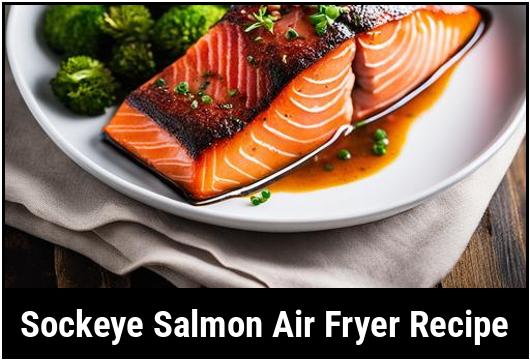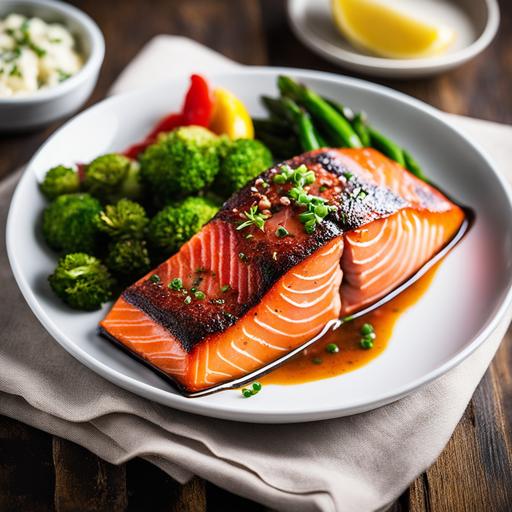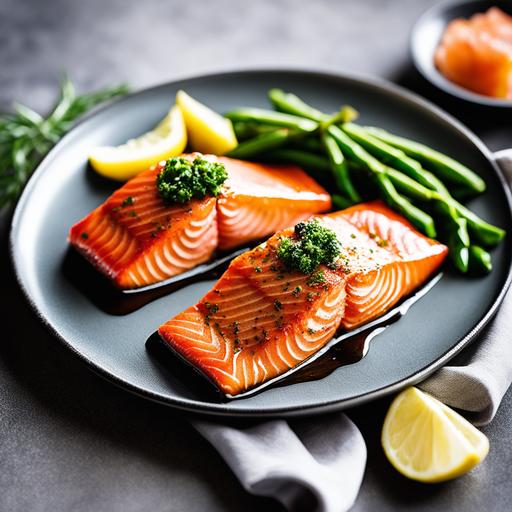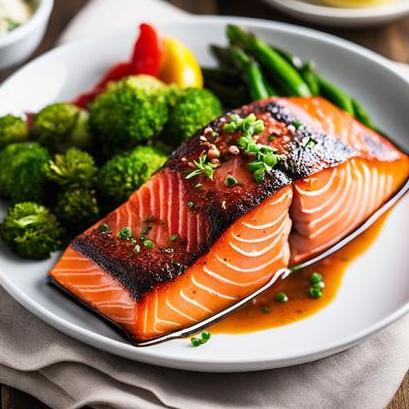Comprehensive Guide To Sockeye Salmon Air Fryer Recipe

Welcome to our comprehensive guide to preparing a delicious and healthy sockeye salmon using an air fryer! In this article, we will delve into the food science behind cooking salmon, discuss various culinary details, guide you through the selection and cleaning process, offer valuable tips and variations, teach you how to check the doneness of your salmon, and finally, share a mouthwatering sockeye salmon air fryer recipe. So, let’s get started!
The Science behind Cooking Sockeye Salmon
Sockeye salmon is not only incredibly delicious but also packed with essential nutrients such as omega-3 fatty acids, vitamins, and minerals. To preserve its nutritional value while making it appetizing, understanding the food science behind cooking is crucial.
High Heat Versus Nutrients Preservation
When cooking salmon, the challenge lies in striking the right balance between applying enough heat to cook the flesh and maintaining the nutritional content. Traditional cooking methods like grilling or pan-frying can sometimes cause overcooking or nutrient loss.
However, using an air fryer helps overcome these challenges. Air fryers use hot air circulation to cook food, resulting in a crispy exterior while sealing in the essential nutrients needed for overall health and well-being. In fact, research has shown that air frying can significantly reduce fat content without compromising taste or texture.
Culinary Details
Selecting the Perfect Sockeye Salmon
To achieve the best results, it is vital to select the right sockeye salmon. Look for wild-caught salmon rather than farmed, as wild-caught salmon tends to have a richer flavor and a firmer texture. Check for bright, firm flesh with no discoloration or strong fishy odor.
Cleaning the Salmon
Before cooking, it’s imperative to clean the salmon properly. Start by rinsing the fish under cold, running water to remove any external scales or debris. Pat it dry with paper towels to ensure an even cooking process.
Preparation and Tips

Preparing the Salmon for Air Frying
- Preheat your air fryer to the recommended temperature, usually around 400°F (200°C).
- Season both sides of the salmon fillets with your preferred seasoning. Popular options include a simple mix of salt, pepper, and lemon zest, or a combination of herbs like dill and thyme.
- Brush the air fryer basket with a thin layer of oil or use non-stick cooking spray to prevent the salmon from sticking.
- Carefully place the seasoned salmon fillets in the air fryer basket, ensuring they are arranged in a single layer for even cooking.
- Close the air fryer and set the cooking timer based on the thickness of your fillets. Generally, for 1-inch thick fillets, start with 10-12 minutes of cooking time.
Important Tips for Cooking Sockeye Salmon in an Air Fryer
- Avoid overcrowding the air fryer basket, as it can hinder proper air circulation and lead to uneven cooking.
- If you have larger fillets, consider cutting them into smaller portions to ensure even cooking throughout.
- Don’t be afraid to experiment with different seasonings, such as Cajun spice, garlic butter, or teriyaki marinades, to add extra flavor to your salmon.
- For added moisture and flavor, you can brush the salmon with olive oil or melted butter before seasoning.
- Remember to flip the salmon halfway through the cooking process to achieve a perfectly crisp exterior and tender center.
Doneness Checks

Effectively checking the doneness of your sockeye salmon is crucial to ensure it is cooked to perfection. Here are a couple of methods to help you determine when your salmon is ready:
- Visual Inspection: Carefully observe the color and texture of the fish. Cooked salmon should have a vibrant pinkish-red color with translucent flesh in the center. It should easily flake when tested with a fork.
- Internal Temperature: Use a food thermometer to check the internal temperature of the salmon. The FDA recommends cooking salmon to an internal temperature of 145°F (63°C). Insert the thermometer into the thickest part of the fillet without touching the bone.
Recipe: Sockeye Salmon Air Fryer Delight

Now that you have all the necessary information, let’s dive into a delectable sockeye salmon air fryer recipe:
Ingredients:
- 4 sockeye salmon fillets (approximately 6 oz each)
- Salt and pepper, to taste
- Olive oil or non-stick cooking spray
- Lemon wedges, for serving
Instructions:
- Preheat the air fryer to 400°F (200°C).
- Season both sides of the salmon fillets with salt and pepper.
- Lightly brush the air fryer basket with olive oil or use non-stick cooking spray to prevent sticking.
- Place the seasoned salmon fillets in the air fryer basket, ensuring they’re arranged in a single layer.
- Close the air fryer and cook for approximately 10-12 minutes, flipping the salmon halfway through the cooking process.
- Confirm the salmon’s doneness by checking its visual appearance (vibrant color, flaky texture) or using a food thermometer to ensure it reaches an internal temperature of 145°F (63°C).
- Once cooked, remove the salmon from the air fryer and let it rest for a few minutes before serving.
- Squeeze fresh lemon juice over the salmon fillets and enjoy!
Variations and Serving Suggestions

Now that you have mastered the basic sockeye salmon air fryer recipe, feel free to experiment with different variations to suit your taste preferences. Here are a few ideas to get you started:
- Citrus Glaze: Mix orange juice, lemon juice, honey, and a touch of soy sauce to create a tangy glaze for your salmon.
- Herb-Crusted Salmon: Combine breadcrumbs, fresh herbs like parsley and thyme, and a sprinkle of Parmesan cheese for a crispy crust.
- Serve with a Side: Accompany your salmon with roasted vegetables, a refreshing salad, or steamed rice for a complete and balanced meal.
Conclusion
Congratulations! You now possess a comprehensive understanding of cooking sockeye salmon using an air fryer. We have explored the food science behind preserving nutrients, provided culinary details, discussed the selection and cleaning process, shared valuable tips, taught you how to check for doneness, and finally, shared a delicious sockeye salmon air fryer recipe. With this knowledge, you can confidently prepare a mouthwatering salmon dish that is both healthy and flavorsome. So, grab your air fryer and start creating culinary wonders with sockeye salmon today!
Sources
FAQS On Sockeye Salmon Air Fryer Recipe
What Is Sockeye Salmon?
Sockeye salmon, also known as red salmon, is a type of salmon that is known for its bright red flesh and high fat content, making it great for cooking in an air fryer.
Can You Cook Sockeye Salmon In An Air Fryer?
Yes, you can definitely cook sockeye salmon in an air fryer. In fact, cooking sockeye salmon in an air fryer is a healthier and more convenient way to enjoy this delicious fish.
What Are The Benefits Of Cooking Sockeye Salmon In An Air Fryer?
Cooking sockeye salmon in an air fryer allows you to enjoy the delicious taste of this fatty fish without all the added oils and fats. It also cooks the fish evenly and quickly, ensuring a perfectly cooked meal every time.
How Long Should I Cook Sockeye Salmon In An Air Fryer?
The cooking time for sockeye salmon in an air fryer will vary depending on the size and thickness of your fillets. As a general guideline, 10-15 minutes at 375°F should be sufficient.
Do I Need To Preheat My Air Fryer Before Cooking Sockeye Salmon?
It is recommended to preheat your air fryer before cooking sockeye salmon. This allows the air fryer to reach the desired cooking temperature and ensures that the fish cooks evenly.
What Are Some Seasonings That Go Well With Sockeye Salmon In An Air Fryer?
Sockeye salmon has a rich, robust flavor that can be enhanced with a variety of seasonings including lemon pepper, dill, garlic, and honey mustard. Experiment with different combinations to find your favorite.
Can I Use Frozen Sockeye Salmon In An Air Fryer Recipe?
Yes, you can use frozen sockeye salmon in an air fryer recipe. It is important to thaw the salmon completely before cooking and adjust the cooking time accordingly. Also, make sure to pat the fish dry before seasoning and cooking.


